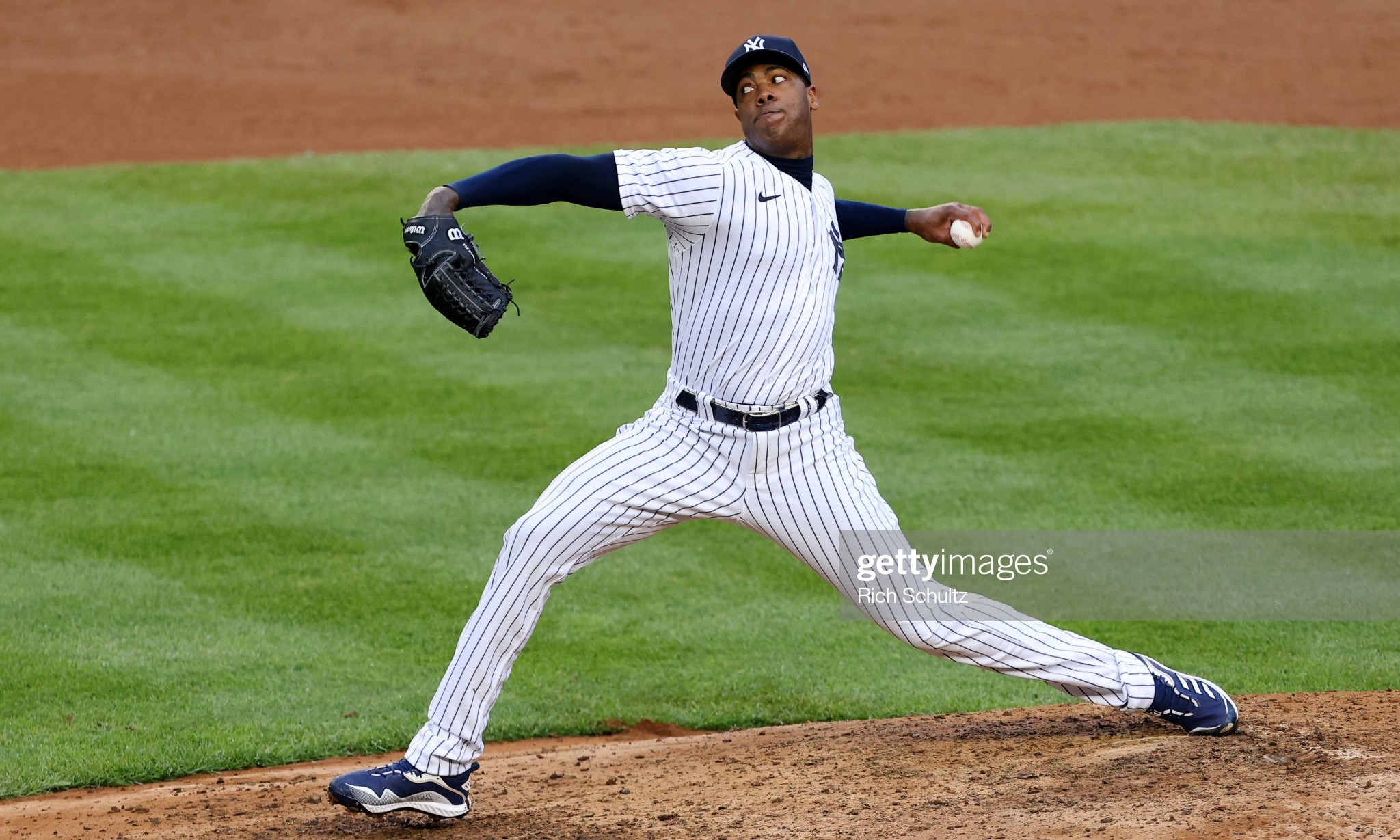Aroldis Chapman has long been one of baseball’s most feared relievers. The flamethrowing southpaw is known for his incredible velocity, including a 2010 pitch now measured at 105.8 mph.
Of course, that was in 2010. That’s a long time ago, and the game has changed a surprising amount in the past 11 years. In 2010, the average fastball velocity was about 91.7 mph. In 2019 (two years ago), it was 93.1 mph. There are significantly more pitchers throwing much harder these days, and 100 mph doesn’t seem to be an extreme outlier anymore.
Naturally, this made Chapman’s fastball less and less effective. As hitters are bombarded with higher and higher speeds, those speeds become easier to adjust for. So, how has Chapman been able to sustain his success?
The answer is simple: he’s become a pitcher.
Throwing ≠ Pitching
Yes, of course, Chapman was a pitcher before. But he wasn’t exactly pitching. Let me explain.
In 2010, Chapman’s rookie year, he threw his fastball over 75% of the time. In following years, that number increased (84.3% in 2011, 87.6% in 2012, 85.2% in 2013, says Baseball Savant). Essentially, from 2011 to 2013, he was a one-pitch pitcher.
To put it in simple terms, Chapman was basically just throwing his fastball as hard as he could. Of course, I’m not saying he didn’t worry about mixing pitches, or location. But his repertoire was much simpler than the average pitcher, and his method of attacking hitters was also much simpler than the average pitcher.
Now, this isn’t a criticism. It worked, very well actually. During those years (2010-2013), Chapman recorded a 2.40 ERA (166 ERA+), with 77 saves in 90 opportunities. In 2012, he was an NL All-Star, finished 8th in NL Cy Young voting, and 12th in the NL MVP race.
So, yeah. Chapman’s method was clearly working extremely well. But nothing lasts forever.
Aroldis’ Adjustments
Everyone that has watched the 2021 New York Yankees is likely aware of how successful Chapman has been this year. Through 13 appearances, he has yet to allow an earned run, striking out 29 (in 13 innings!) with only 4 walks. He also has an absurd FIP of -0.44.
Yes, the season is still very young. However, this is probably the most dominant Chapman has looked since that 2012 campaign. So, let’s compare the two.
In 2012, Chapman’s average fastball velocity was 98.4 mph. In 2021, it’s currently 99.0 mph. This contradicts what I said before, about his fastball being less effective, right? Well, let’s take a deeper look.
In that 2012 season, Chapman threw his fastball 87.6% of the time, as I mentioned earlier. That year, batters hit just .150 against the pitch, with a whiff rate of 37.4%. In 2021, Chapman has thrown his fastball just 52.1% of the time. Batters are hitting .250 (xBA of .187) against the heater, with a whiff rate of 25.5% (Baseball Savant).
So his fastball has clearly been less effective this year than that famed 2012 season. Yet, Chapman has still maintained his overall effectiveness. But how?
We Want a Pitcher
Through the years, Chapman has become a much better overall pitcher, and this season is the best example of that.
I mentioned that Chapman has only thrown his fastball 52.1% of the time this season. So what else is he throwing?
At the tail end of the 2020 season, the big lefty re-introduced a long-lost pitch to his repertoire. When Chapman first came through the minors, he was a starter (as was basically every pitcher initially). During that time, he featured a splitter in his arsenal.
“Unfortunately, when I was playing for the Cincinnati Reds, they didn’t like me throwing that pitch because I was younger at the time and they felt that it was unnecessary. But I’ve always liked using this pitch,” Chapman said in April.
Chapman threw his splitter just three times in the 2020 regular season, but it’s played a major role this year. He’s featured the pitch on 13.3% of his offerings, and has an astonishing whiff rate of 71.4%. 8 at-bats this season have ended in the splitter, and – get this – all 8 of them have resulted in strikeouts. Not only does that give hitters a .000 average against the splitter, it also keeps their xBA at .000. Can’t get a hit if you don’t put the ball in play.
Chapman has also long featured a slider, but it is a pitch that has seen renewed effectiveness this year. 4 at-bats have ended in the slider, and 3 of them resulted in strikeouts. An xSLG of .036 is a far cry from 2020’s number of .333 (Yeah, yeah, I know, small sample size. It’s still a wild stat to look at).
He’s also supplemented his fastball with a sinker. The pitch was introduced to Chapman’s arsenal in 2018, and he’s thrown it 13.8% of the time this season. In 14 at-bats ending in the sinker, he still has yet to allow a hit, and 12 of those at-bats have ended in strikeouts.
A New Arsenal
Okay, those were a lot of numbers. Let’s digest it all. Essentially, Chapman has yet to allow a single hit off three of his four pitches. Out of 42 total at-bats against Chapman in 2021, 26 of them have ended in a sinker, slider, or splitter. Of those 26 at-bats, not a single one has ended with a hit, and 23 (23!) of them resulted in strikeouts. Overall, Chapman has a K-rate of 61.7% this season, which would be (by far) the highest of his career (numbers from Baseball Savant).
Now, instead of simply blowing a fastball by everyone, Chapman can use his fastball to set up a series of nasty offspeed weapons. The sinker (which averages 100.8 mph this year) also allows him to use that high velocity, with a bit of movement thrown in for good measure.
Chapman’s slider has an average horizontal movement of 8.3 inches above average. This is, by far, the highest figure for his slider since the stat has been tracked (2016). He also has recorded a run value of at least -1 for all four pitches. In 2020, the only pitch of the four with a negative run value was his fastball.
One of the big factors is also Chapman being able to build that velocity back up. As we’ve discussed, he initially had success by just throwing his fastball by everybody. His average fastball velocity peaked at 101.1 mph in 2017, and decreased in each of the next three seasons. The 99.0 mph average that Chapman has posted in 2021 in the highest since that 2017 season, and a 1.2 mph increase from 2020.
“I think he’s becoming a more complete pitcher, while also still retaining some of those elite qualities he’s had in the past,” said pitching coach Matt Blake in April.
Chapman has been the backbone of the Yankee bullpen for several years now. This year, however, he looks better than he ever has, and it’s helped the Yankee ‘pen to be one of the best in the majors.
And he’s done it by becoming a pitcher.




